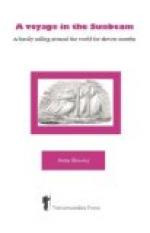Thursday, December 7th.—At eight o’clock I took Mabelle and Muriel for a drive in a pony-carriage which had been kindly lent me, but with a hint that the horse was rather mechant sometimes. He behaved well on the present occasion, however, and we had a pleasant drive in the outskirts of the town for a couple of hours.
Just as we returned, a gentleman came and asked me if I should like to see some remarkably fine pearls, and on my gladly consenting, he took me to his house, where I saw some pearls certainly worth going to look at, but too expensive for me, one pear-shaped gem alone having been valued at 1,000_l_. I was told they came from a neighbouring island, and I was given two shells containing pearls in various stages of formation.
It was now time to go on board to receive some friends whom we had invited to breakfast, and who arrived at about half-past eleven.
[Illustration: A Tahitian Lady.]
After breakfast, and a chat, and an examination of the photograph books, &c., we all landed, and went to see Messrs. Brander’s stores, where all sorts of requisites for fitting out ships and their crews can be procured. It is surprising to find how plentiful are the supplies of the necessaries and even the luxuries of civilised life in this far-away corner of the globe. You can even get ice here, for the manufacture of which a retired English infantry officer has set up an establishment with great success. But what interested me most were the products of this and the neighbouring islands. There were tons of exquisitely tinted pearl shells, six or eight inches in diameter, formerly a valuable article of commerce, but now worth comparatively little. The pearls that came out of them had unfortunately been sent away to Liverpool—1,000_l_. worth by this morning’s, and 5,000_l_ by the last mail-ship. Then there was vanilla, a most precarious crop, which needs to be carefully watered and shaded from the first moment it is planted, and which must be gathered before it is ripe, and dried and matured in a moist heat, between blankets and feather-beds, in order that the pods may not crack and allow the essence to escape. We saw also edible fungus, exported to San Francisco, and thence to Hong Kong, solely for the use of the Chinese; tripang, or beche-de-mer, a sort of sea-slug or holothuria, which, either living or dead, fresh or dried, looks equally untempting,




